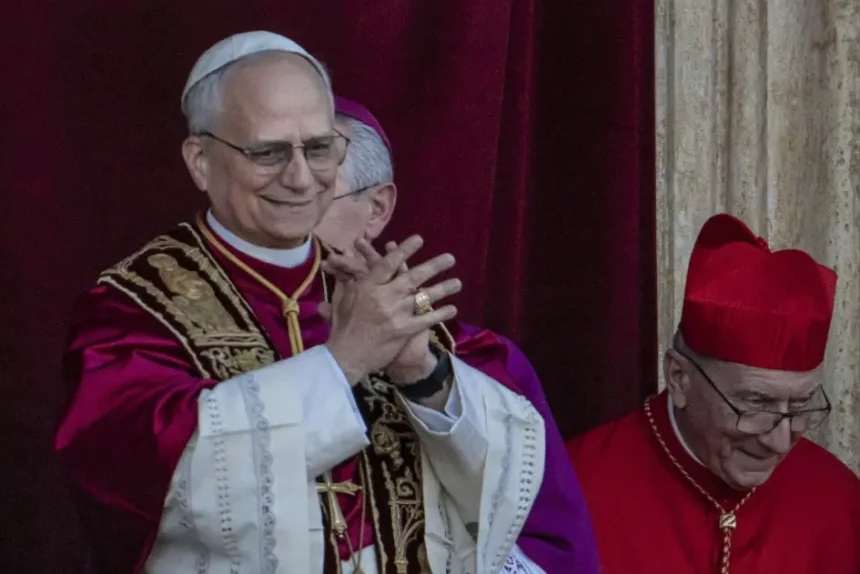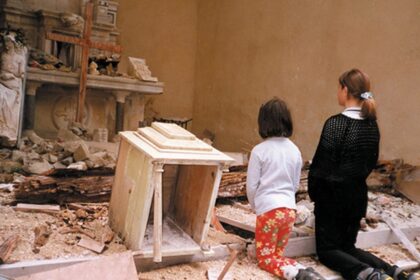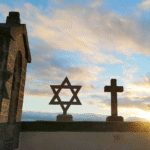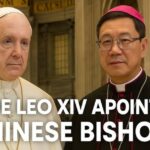VATICAN CITY – Newly elected Pope Leo XIV faces a tough diplomatic challenge: the Vatican-China Agreement of 2018. This deal aimed to heal a decades-long rift, hoping to bring China’s divided Catholic community together by giving both Beijing and Rome a say in picking bishops.
Supporters thought it would strengthen the Church and ease tensions. Instead, the agreement has sparked deep controversy, with critics saying it paved the way for rising state control and mounting pressure on underground Catholics.
Calls for Pope Leo XIV to review the deal have grown louder since his election. Many faith and rights groups believe the original plan failed to protect religious freedom. The agreement, which remains at the centre of Vatican diplomacy, now sits high on Pope Leo’s agenda as he decides whether to defend, change, or scrap it for good.
Background: The 2018 Vatican-China Agreement – Ambitions and Anxieties
Catholics in China have long been split between the state-approved “official” Church and a resilient underground community loyal to the Vatican. For decades, both groups practised their faith under pressure, often at risk of government punishment or forced secrecy. The Holy See watched these divisions with growing concern, seeking unity for China’s Catholics and aiming to heal a rift that had lasted since the Communist takeover in 1949. Out of this wish for reconciliation came the 2018 Vatican-China Agreement, an attempt at a diplomatic balancing act with very high stakes.
The agreement generated hope but also triggered new worries. While some believed it would finally unite China’s Catholics under the Holy See and improve religious freedom, others called out the lack of clarity and ongoing risks for those outside state control. The Pope and the Chinese government saw a chance for cooperation, but for many faithful, the details remained worryingly vague.
Key Provisions of the Agreement
At the core of the 2018 agreement lies the question of who picks Catholic bishops in China—a role filled with spiritual and political weight. Traditionally, the Vatican alone has the authority to name bishops. But for years, China’s government appointed its bishops, often without Rome’s blessing, leaving both the faithful and clergy caught in the middle.
The deal outlined a new system:
- Local Church communities propose bishop candidates.
- Chinese authorities vet these candidates and submit names to the Pope.
- The Pope then gives formal approval or can exercise what has been called a “veto” power.
The supposed veto is key. In theory, Rome keeps final say over China’s bishops, preserving the Pope’s global authority. In practice, critics doubt how much influence the Holy See holds if Beijing rejects candidates behind closed doors.
Despite hopes for unity and progress, much of the process remains hidden from public view. The full text has never been released, fueling speculation about who truly holds power in these pivotal appointments. For more insight into the text’s secrecy and the real-world results, see this detailed report by Human Rights Watch.
Opaque Diplomacy and Historical Parallels
Perhaps the most striking thing about the 2018 agreement is how secretive it remains. Few outside top-ranking officials know what was signed. The deal joins a list of Vatican diplomatic moves shrouded in confidentiality, where details are assumed rather than shared.
This isn’t Rome’s first secretive engagement with authoritarian powers. If you look back at historic Vatican agreements, like the 1933 Concordat with Nazi Germany, similar patterns emerge: confidentiality, compromise, and the hope of protecting the Church’s flock. Such arrangements sometimes offered peace or protections on paper, but could also carry long-term risks.
Even now, critics question whether “constructive engagement” with China has made things better or just quieted open criticism. The secrecy has, if anything, left underground Catholics more vulnerable, with the government tightening control and freedoms slipping away.
For readers interested in the full background and history of the Holy See’s strategy in China, this overview of China–Holy See relations covers how the Vatican’s diplomatic advances have played out before and what the stakes are now. The Vatican must weigh hope for unity against the persistent risk that history could repeat itself, leaving faithful Catholics once again caught in the crossfire.
Tensions and Controversies: Implementation Since 2018
When the Vatican and China signed the historic 2018 agreement, many expected new openness and collaboration. In reality, the path since 2018 has been uneven, sparking heated debate within the global Catholic community. While the ink of diplomacy dried, pressure on everyday Catholics in China only seemed to increase. Critics have questioned whether either side lived up to their end of the deal, with major points of friction visible in both church leadership and day-to-day worship.
Unilateral Actions and Canonical Concerns
Despite the agreement’s clear framework for appointing bishops, the Chinese government has continued to make moves without Vatican approval. Authorities have named bishops independently, sometimes ignoring the process set out in the deal. This raises canonical and theological questions about the legitimacy of such appointments, deepening the existing split between state-approved and underground Catholic communities.
- Since 2018, only about 10 bishops have been jointly appointed under the agreement, out of over 90 dioceses across mainland China. That leaves a vast majority of dioceses still in uncertainty or led by bishops picked without Rome’s blessing. For up-to-date stats and details, see this Human Rights Watch analysis.
- The Vatican, for its part, has expressed regret and concern when China makes appointments on its own. At times, Rome issued statements noting these moves “do not conform to the spirit of dialogue.” Such incidents signal a breakdown in trust and a growing anxiety within the Holy See about its actual influence.
- Theologically, unauthorized appointments undermine the Pope’s universal authority as head of the Catholic Church. For practising Catholics, this muddles the lines between faithfulness to Rome and loyalty to local authorities—an impossible situation with deep spiritual and practical effects.
Some inside the Vatican have warned that allowing China’s unilateral actions erodes not just protocol, but the centuries-old role of the Papacy in safeguarding global Church unity. The practical result? Chinese Catholics often face conflicting loyalties, with clergy caught in the middle of competing worlds.
Sinicization and Repression of Catholics
Beijing’s push for Sinicization—making religion more “Chinese” and loyal to state ideals—has left the Catholic Church under growing control. The government has stepped up surveillance, monitored religious gatherings, and torn down churches. Even government-registered churches must fly the national flag, post propaganda, and teach loyalty to communist leaders alongside Christian doctrine.
Recent unofficial reports and first-hand accounts point to these troubling trends:
- Underground priests and bishops have faced police raids, forced disappearances, or long detentions. High-profile clergy arrests have made headlines, with no clear legal process or outside contact for those taken.
- Some local believers risk heavy fines or loss of basic services if caught worshipping outside the official system.
- Church demolitions, especially in rural provinces, have become more common since 2018. Even state-approved churches have been bulldozed if leaders resisted ideological controls.
This heightened pressure fits into China’s larger campaign against unregistered faith communities, where Catholics are just one group among many facing crackdowns. Sinicization is not a policy on paper alone; it touches real lives, with families torn apart, worship spaces shut, and laity living under constant threat.
The agreement, rather than shielding the underground community, appears to have left it more exposed. With the state’s power growing stronger, underground leaders who hoped for legal status now find themselves even further marginalized. The cycle of surveillance, detention, and erasure has sped up in recent years, dampening hopes for a more open or unified Catholic presence in China.
For a recent review of these patterns and Vatican-China diplomatic efforts, see this report from Catholic News Agency.
Far from healing old wounds, the agreement’s implementation has opened new ones. Each side’s selective cooperation or outright disregard for the terms feeds mistrust and anxiety among China’s millions of Catholics. The new Pope faces not just a political challenge, but a deeply personal one for all those trying to follow their faith under difficult—and sometimes dangerous—conditions.
Human Rights Criticism and Calls for Reform
The Vatican-China agreement promised unity for a divided Catholic flock but opened a torrent of questions about human rights. Voices inside the Vatican, among China’s Catholics, and around the world’s rights groups have warned that the deal may be failing those most in need of protection. As Beijing’s grip on religion tightens, calls for justice and real reform grow louder by the year.
Persistent Persecution: Case Studies
Since the agreement, several cases have stood out as stark examples of religious repression. These stories, marked by disappearances and harsh state action, fuel skepticism about the Vatican’s diplomatic efforts.
- Bishop James Su Zhimin: Bishop Su, long seen as a pillar of the underground Catholic Church in Hebei, vanished into detention more than two decades ago. Despite international pleas, authorities have offered no meaningful updates on his condition or whereabouts. His ongoing disappearance speaks volumes about the dangers faced by clergy outside state control.
- Bishop Augustine Cui Tai: Detained several times since 2018, Bishop Cui has spent most of the past five years in secret detention or under intense surveillance. Reports from his diocese describe repeated cycles of disappearance and brief, restricted home visits. Parishioners are often threatened for trying to reach him.
- Bishop Joseph Zhang Weizhu: In 2021, Bishop Zhang was taken by police after leading prayers in Xinxiang, Henan province. He was held with several priests and dozens of faithful. Their only “crime” was worshipping without official approval.
- Wider pattern: These are only the most visible stories. Every year, other priests, lay leaders, and ordinary believers are detained, fined, or harassed. Entire faith communities have been driven underground.
Global rights groups, from Amnesty International to Human Rights Watch, argue that these cases highlight deeper trends. They point out that repression extends beyond Christianity, affecting Muslims, Tibetan Buddhists, and followers of Falun Gong. For a wider look, Amnesty details broad Chinese measures restricting religion, including threats and intimidation against believers across different faiths (Human Rights in China).
This pattern is no passing phase. China’s policy toward all non-state-approved religious activity remains strict. In-depth reporting by Human Rights Watch outlines ongoing religious repression in China, from long sentences to the closure of worship spaces. The fate of these bishops and their flocks keeps the debate on human rights and religious freedom front and centre.
Debate Within the Church and the Global Community
The Vatican-China deal has fuelled an urgent debate, not just among policy specialists but within the Church’s own heart. At issue is whether ongoing talks with Beijing show careful strategy or surrender of principle.
Inside the Vatican, opinions are split. Some senior prelates have called for patience, arguing that steady talks with China serve the long-term goal of unity and legal status for Catholics. Others, including vocal cardinals and bishops, say the agreement represents a grave compromise. They worry the Vatican now risks appearing “complicit” in state repression by remaining silent about ongoing abuses (The Vatican’s Disgraceful China Deal Ought to End).
Among theologians and laypeople, skepticism is even sharper. Ordinary Catholics in China, especially those outside the official system, say the deal left them more exposed. Local reports paint a picture of believers facing tougher choices: join the state-sanctioned church and accept tight controls, or risk detention and marginalization by practising underground.
Key points in the debate include:
- Loss of moral clarity: Many critics argue that the Vatican’s muted response to repression undermines its voice around justice and dignity.
- Betrayal of the underground Church: High-profile Catholics and rights advocates see the agreement as abandoning those who have stayed loyal to Rome through years of hardship (The many problems with the Vatican’s China deal).
- Fears of a global precedent: Some warn that if the Vatican accepts tight state control in China, it may weaken the Church’s ability to defend religious liberty elsewhere.
On the global stage, rights groups have urged Pope Leo XIV to order a full review of the accord. They want progress on transparency, real protections for persecuted leaders, and a stronger Vatican voice in defence of religious freedom (Holy See: Review Vatican-China Agreement).
The debate is far from settled. While some counsel prudence, others demand bold action. At the centre are millions of Chinese Catholics left struggling with the real-life effects of policy, diplomacy, and silent suffering.
Pope Leo XIV’s Options: Charting a Way Forward
Pope Leo XIV stands at a crossroads few leaders ever face. After years of tension and dashed expectations, Chinese Catholics and the global Church look to him to act decisively on the Vatican-China deal. Every decision will carry weight, affecting millions who hope for justice and unity. What next steps could he take? The options span delicate diplomacy, assertive advocacy, and a renewed push for human dignity.
Potential Diplomatic Pathways: Prospects for Renegotiation, Compliance Demands, or Annulment
The tools on the Pope’s desk aren’t just theoretical—they’ll shape the future for Catholics in China. Here’s how the possible moves stack up:
- Renegotiation: Pope Leo could invite Beijing back to the table, aiming for stricter safeguards and greater clarity in the appointment of bishops. By insisting on regular reviews, public reporting, and consultation with local Church leaders, the Vatican might pressure China to loosen state control, at least in appearance. This approach appeals to those hoping for constructive reform without severing dialogue. Yet, trust has frayed after years of unofficial appointments and crackdowns, so results are far from guaranteed.
- Demands for Compliance: Rather than rewriting the deal, the Holy See could push China to follow the original agreement to the letter. Publicly holding Beijing accountable for current failings, such as unauthorized bishop appointments or suppression of churches, would signal a firmer Vatican stance. Advocates for this line argue that the Church’s global standing depends on not ignoring clear violations or hiding behind diplomatic pleasantries. As highlighted in this analysis by Human Rights Watch, pushing for transparency and compliance could restore credibility, but risks open conflict with Chinese authorities.
- Annulment or Withdrawal: If talks stall or persecution intensifies, Pope Leo could choose to suspend or annul the deal outright. This path would likely provoke official outrage from Beijing and could have real consequences for Catholics at risk, especially those in the underground Church. Still, many voices—especially among rights groups and underground Catholics—argue that standing up for principle would reassert the Vatican’s moral authority, even at a steep short-term cost.
Every option carries trade-offs. Renegotiation might allow room for incremental gains. Compliance demands could restore lost trust and transparency. Annulment, the boldest path, would draw a clear red line but could also isolate local Catholics further. Strategic thinkers warn that any chosen path should blend principle with pragmatism, weighing not only the headlines but the everyday lives caught in the middle. A deeper dive into Pope Leo’s possible strategies appears in the piece, On Pope Leo’s Desk: The Vatican-China deal, which breaks down recent Vatican responses and the risks in pushing back too hard—or not hard enough.
Advocating for Religious Freedom and Human Dignity
For many, Pope Leo’s most pressing job is to defend those with the least voice: China’s underground Catholics. As calls for reform grow louder, he faces a moral test. Will the Vatican return to quiet diplomacy, or stand up and demand visible improvements in religious freedom?
- Protection for Clergy and Laity: The Pope could step up calls for state recognition and safety for underground priests, bishops, and lay leaders. By publicly naming detainees or demanding their safe release, as recommended by leading rights groups in recent reports, the Vatican puts Beijing on notice that the world is watching.
- Broader Religious Tolerance: Beyond Catholic concerns, the Vatican may choose to highlight abuse against all faiths—Muslims, Protestants, Buddhists, and others—strengthening alliances with other countries and global faith movements. By joining calls for an end to forced disappearances, church demolitions, and ideological re-education, Pope Leo could help shape a new global front for religious liberty. This international take from CNN looks at how his statements have already brought wider attention.
- Transparent, Bold Advocacy: Many are urging Pope Leo to do what his predecessor did not—speak, use plain words, and avoid coded language or vague press statements. That means regular updates to the faithful, honest communication with diplomatic partners, and a refusal to quietly accept repression. Calls for this approach have grown, especially after years where official silence amplified suffering.
- Moral Leadership on Human Rights: Throughout history, the Catholic Church’s greatest strength has been its willingness to speak for the voiceless. If Pope Leo frames his approach as a defence of human dignity—using stories from persecuted clergy and laity, sharing the lived realities of faith under threat—he can reset the debate. Doing so positions the Vatican as not just a diplomatic player but as a true advocate for justice.
Any mix of these choices will set the tone for years to come. The Catholic Church—and the world—are watching to see if the Pope will take a stand that places human dignity at the heart of Vatican policy, or whether diplomacy and compromise will prevail. For more on the immediate pressures Pope Leo faces, see the thoughtful update from Persecution.org outlining the harsh realities on the ground and what’s at stake in the months ahead.
Conclusion
Pope Leo XIV steps into a situation full of risk and possibility. His approach to the Vatican-China Agreement will shape much more than policy papers or press releases. The fate of China’s divided Catholic community, the Vatican’s moral voice, and hopes for wider religious freedom all hang in the balance.
There’s no easy fix. Reviewing the deal could bring some hard truths into the open, but it also offers a chance to push for real protections and transparency. The world’s eyes are on Rome, waiting to see if the new Pope chooses quiet negotiation or bold, public leadership.
Whatever Pope Leo decides will echo beyond Church walls, touching millions who practise their faith under pressure and reminding the global community why these choices matter. Readers following this story are encouraged to keep learning, share their thoughts, and stand with those fighting for dignity and faith, no matter where they live.







